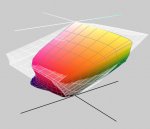imagesetting
Active member
We are considering a Hexachrome workflow, for large format production, I assume ICC profiling can deal with Hexachrome - if we are to profile in house I assume there are industry targets available supplied with most profiling software ?
Our primary purpose of the O & G is to better match Spot Pantones on output on 8 colour large format printers (CMYK Lc Lm OG).
I assume Adobe CS 5.5 can work OK with Hexachrome profiles.
Unless the client possessed a proofing device with Hexachrome, it may cause some confusion on their side - if they wished to take full advantage of the 8 colours with Bitmaps, ideally they should leave the conversion to the 8 colour to us, what would be the best colour space for them to capture images in.
I assume you can have spots with any colour space, although I can only see RGB or CMYK as an option in Indesign ? - ie a file that they can hand to us with this all in.
So as not to overcomplicate matters for certain clients, would it be best to suggest CMYK for Bitmaps and Spot for pantones without any conversion there end.
Where would the conversion best occur, mapping the Spot into the Hexachrome colour space, at the application level or in the RIP.
How well are RAL swatches supported with all this ?. We've very rarely had a design agency quote us RAL numbers, mostly always Pantone Ref's, which comes first in the specifying race RAL or Pantone, if all your work is coloured perspex signs, and you want a few exterior posters or exhibition prints, you'd match to the RAL surely ?
I suppose thinking about it, designers like to sit in airless airconditioned offices specifying from what they see most in their daily work - printed matter (and is that still the case in our digital world).
Hopefully RAL and Pantone would be weel supported Gamut wise under Hexachrome.
It seems machine manufacturers service two mainstream markets - sign making, and litho printing - the former is solvent based for exterior (ie Mimaki, roland), and then the latter - very high end with Pigmented ink with Epson 11880, canon, and HP.
I guess you need two machines to service both markets accurately, does the Epson GS6000 fill the gap - how many clients are going to complain about a lack fo Vivid Magenta and 2 or blacks effecting a van graphic?
Have the likes of Mimaki and Roland moved away from Hexachrome simply because theres no demand, or has the CMYK gamut really increased as manufacturers have perfected more modern CMYK ink sets ?
Our primary purpose of the O & G is to better match Spot Pantones on output on 8 colour large format printers (CMYK Lc Lm OG).
I assume Adobe CS 5.5 can work OK with Hexachrome profiles.
Unless the client possessed a proofing device with Hexachrome, it may cause some confusion on their side - if they wished to take full advantage of the 8 colours with Bitmaps, ideally they should leave the conversion to the 8 colour to us, what would be the best colour space for them to capture images in.
I assume you can have spots with any colour space, although I can only see RGB or CMYK as an option in Indesign ? - ie a file that they can hand to us with this all in.
So as not to overcomplicate matters for certain clients, would it be best to suggest CMYK for Bitmaps and Spot for pantones without any conversion there end.
Where would the conversion best occur, mapping the Spot into the Hexachrome colour space, at the application level or in the RIP.
How well are RAL swatches supported with all this ?. We've very rarely had a design agency quote us RAL numbers, mostly always Pantone Ref's, which comes first in the specifying race RAL or Pantone, if all your work is coloured perspex signs, and you want a few exterior posters or exhibition prints, you'd match to the RAL surely ?
I suppose thinking about it, designers like to sit in airless airconditioned offices specifying from what they see most in their daily work - printed matter (and is that still the case in our digital world).
Hopefully RAL and Pantone would be weel supported Gamut wise under Hexachrome.
It seems machine manufacturers service two mainstream markets - sign making, and litho printing - the former is solvent based for exterior (ie Mimaki, roland), and then the latter - very high end with Pigmented ink with Epson 11880, canon, and HP.
I guess you need two machines to service both markets accurately, does the Epson GS6000 fill the gap - how many clients are going to complain about a lack fo Vivid Magenta and 2 or blacks effecting a van graphic?
Have the likes of Mimaki and Roland moved away from Hexachrome simply because theres no demand, or has the CMYK gamut really increased as manufacturers have perfected more modern CMYK ink sets ?
Last edited:














